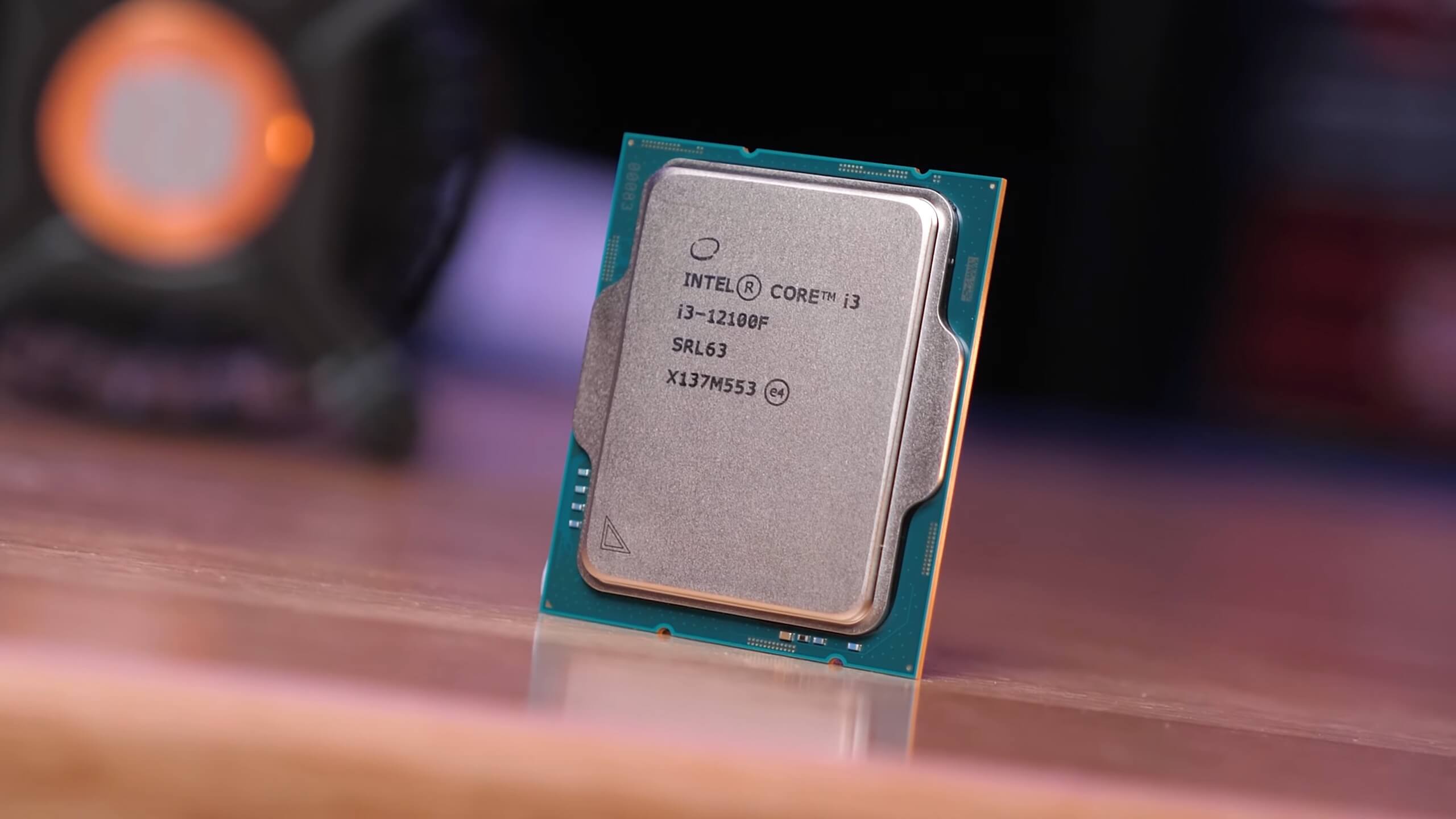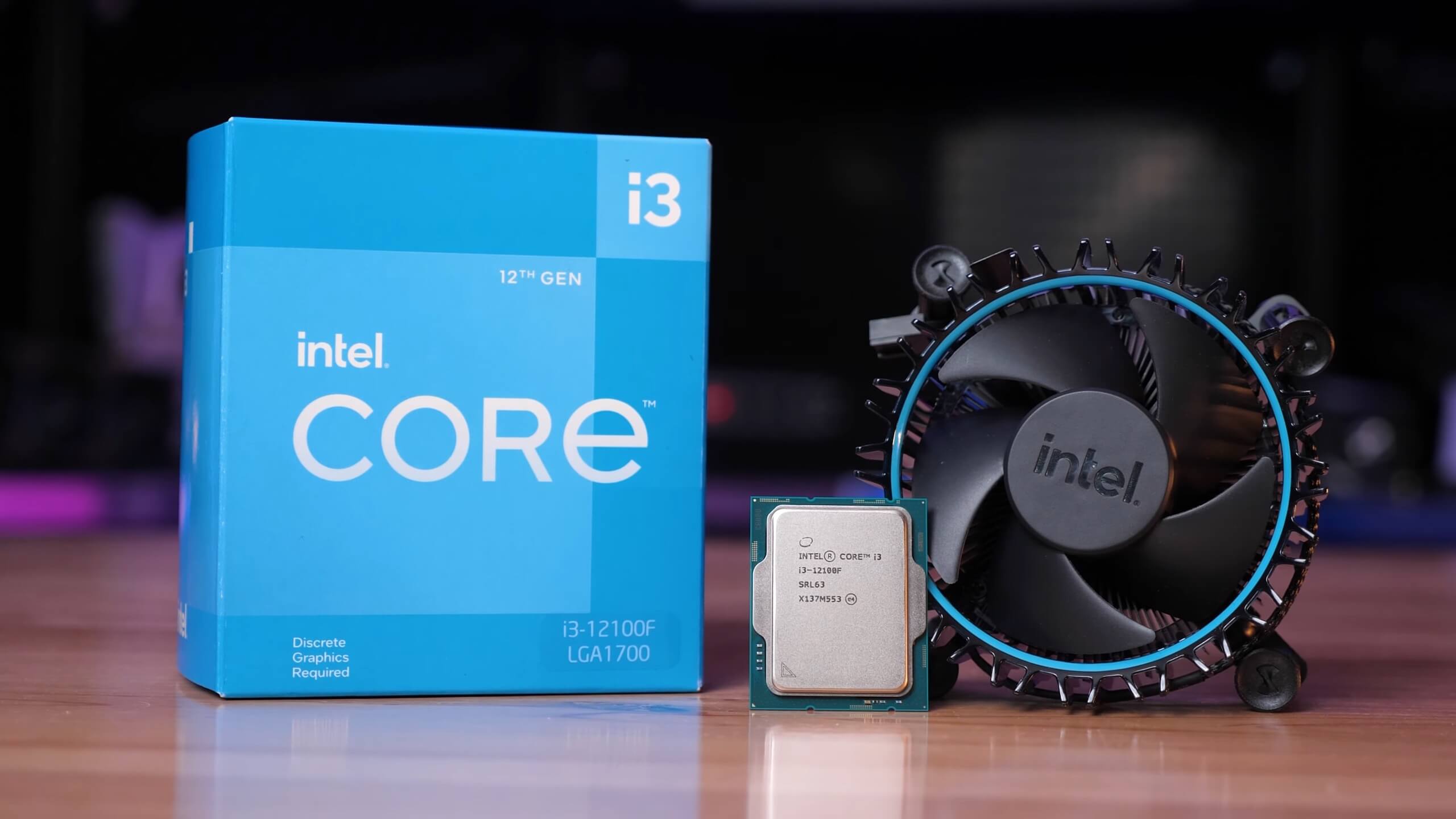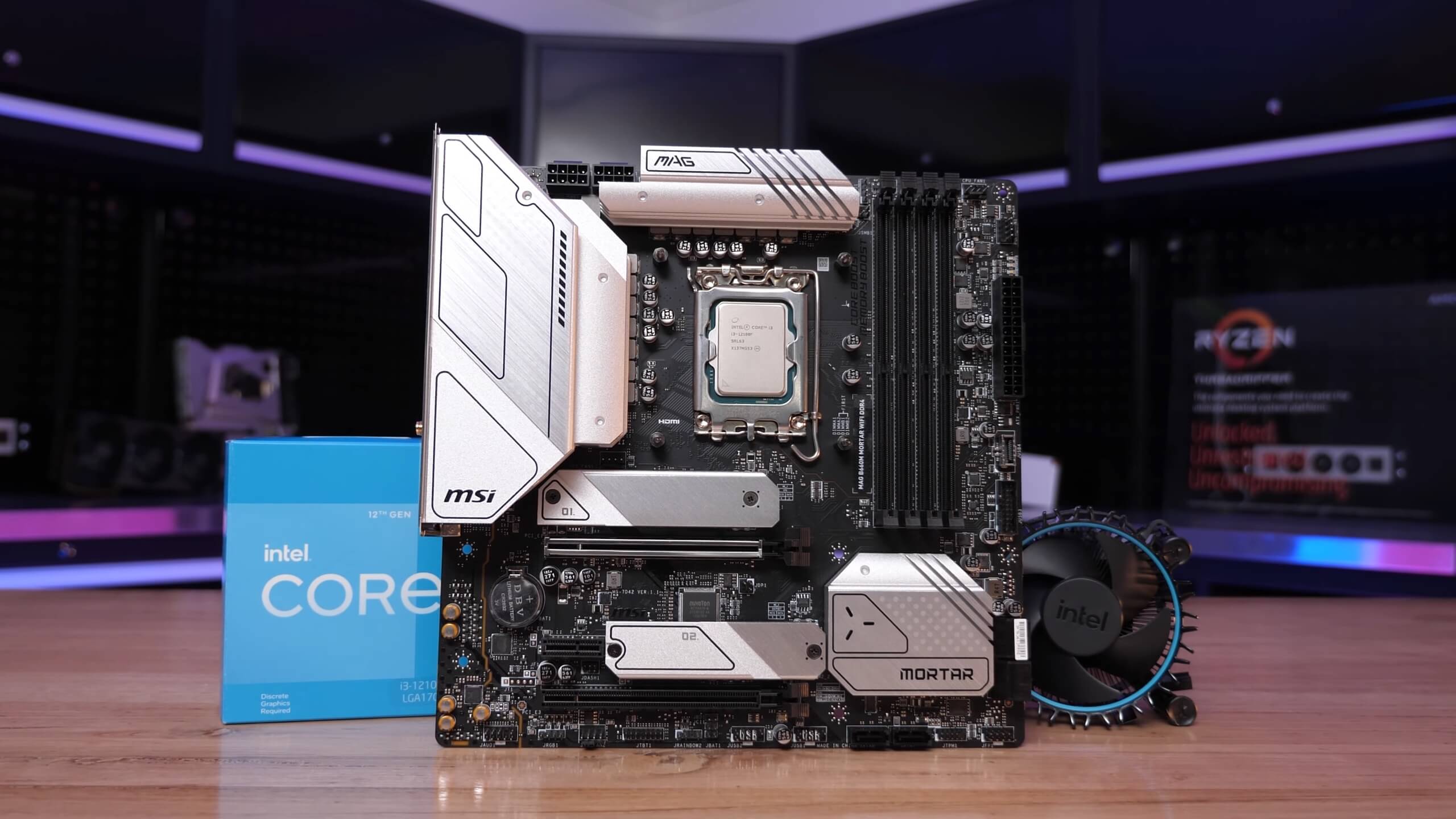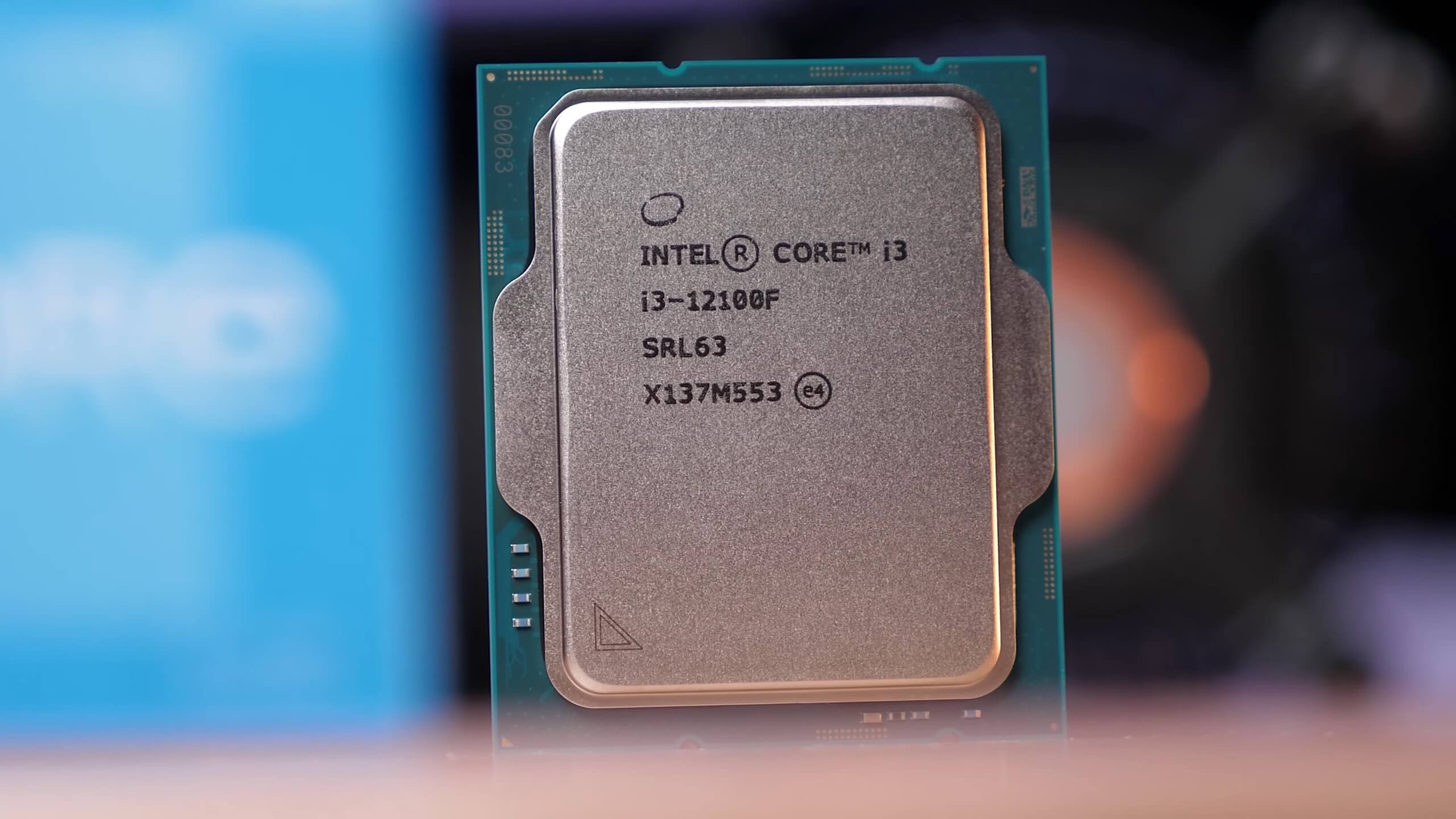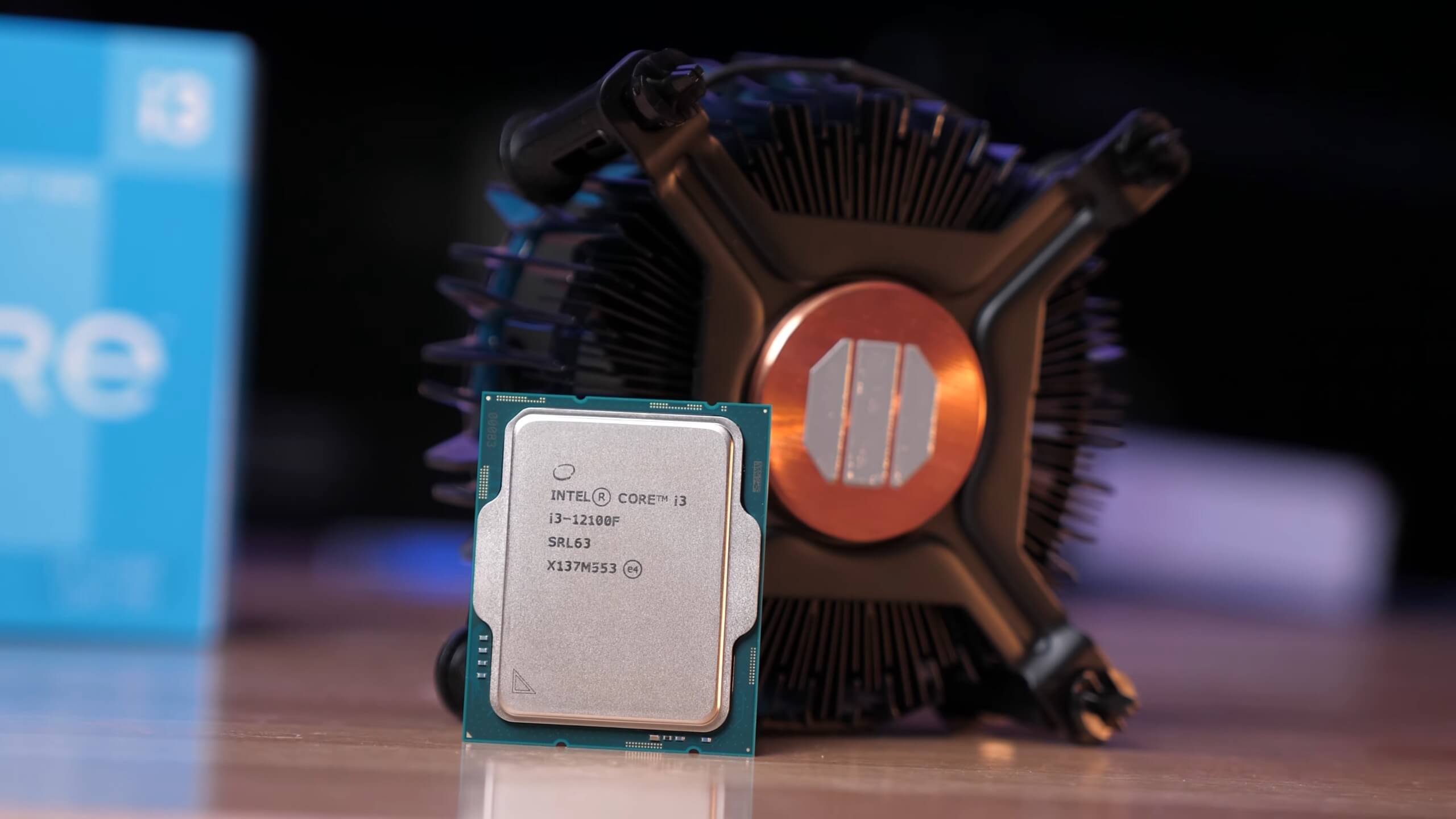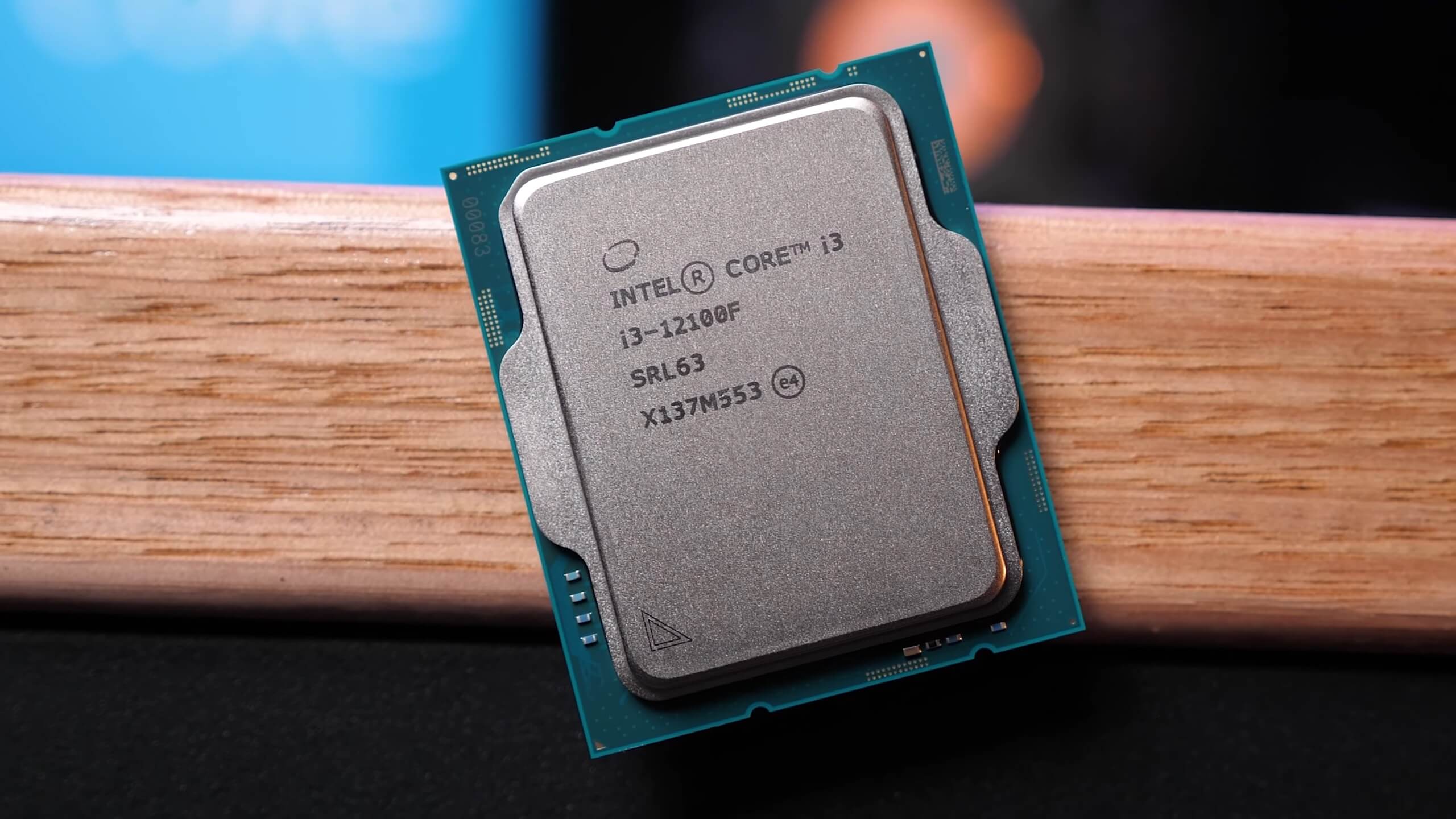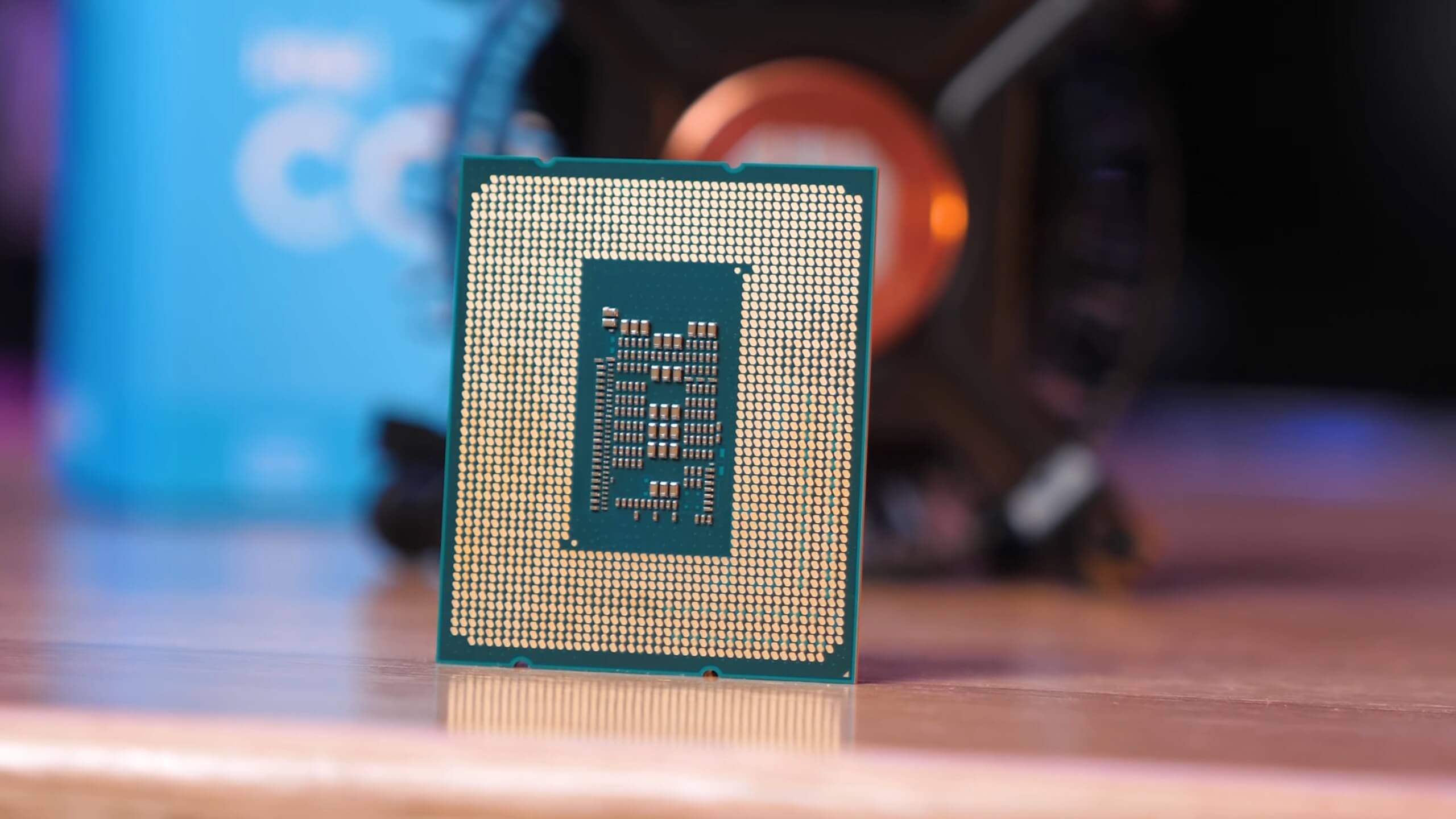About a month ago we purchased a Core i5-12400 for an in-depth review, and we found that for $180 (12400F), it represented excellent value, especially for gamers. The only hiccup at the time was motherboard pricing as the Intel B660 chipset had just launched and no boards were available.
Three weeks later and B660 motherboards are now rolling out. Though not as many as we'd have liked and pricing is still a bit inflated, you can buy a good looking budget B660 board for $140 such as the Gigabyte B660M DS3H AX or Asus Prime B660 Plus D4. In terms of pricing, the same happened with B560 for a few months and even AMD's B550 suffered a similar issue, so hopefully these will become even more affordable over the course of the year.
In our review we estimated that if we could get some decent B660 boards for around $160, the Core i5-12400F would be an excellent option to be unrivaled in the sub-$200 CPU market, and that does appear to be the case.
But what if you want to spend even less on your CPU?
Before we were recommending the Core i3-10100F, which was ~$120 back in October, but later in the holidays dropped to just $92, and now is down to $85, which is crazy considering how capable that CPU is. With decent B560 boards around $110, it's a hard budget combo to beat.
With that said, the new Core i3-12100F which we are testing today is coming in at $120, and with 4 P-cores it should easily outperform the 10100F for what really is a small premium. Yes, it's ~40% more expensive, but we're talking about $35 for what should be a much more powerful CPU. That's one of the angles we'll be looking at, while also comparing the 12100F to several other relevant parts.
Before we jump into the benchmarks, let's quickly go over the 12100F specs. This base model Core i3 processor packs 4 P-cores which operate at up to 4.3 GHz, and with Hyper-Threading there are 8 threads. Included is a 12 MB L3 cache, UHD 730 graphics for the non-F SKU version, and a max turbo rating of 89 watts.
| Intel Core i9 12900K | Intel Core i7 12700K | Intel Core i5 12600K | Intel Core i5 12600 | Intel Core i5 12400 | Intel Core i3 12100F | |
|---|---|---|---|---|---|---|
| MSRP $ | $650 | $450 | $320 | $223 | $192 | $122 |
| Release Date | November 2021 | January 2022 | ||||
| Cores / Threads | 16 / 24 | 12 / 20 | 10 / 16 | 6 / 12 | 4 / 8 | |
| Base Frequency | 2.4 / 3.4 GHz | 2.7 / 3.6 GHz | 2.8 / 3.7 GHz | 3.3 GHz | 2.5 GHz | 3.3 GHz |
| Max Turbo | 3.9 / 5.2 GHz | 3.8 / 5.0 GHz | 3.6 / 4.9 GHz | 4.8 GHz | 4.4 GHz | 4.3 GHz |
| L3 Cache | 30 MB | 25 MB | 20 MB | 18 MB | 12 MB | |
| Memory | DDR5-4800 / DDR4-3200 | |||||
| Socket | LGA 1700 | |||||
For testing the Core i3-12100F we're using the MSI B660M Mortar Wi-Fi DDR4 with 32GB of dual-rank, dual-channel DDR4-3200 CL14 memory. This is the same memory we use for all our DDR4 testing and it's typically faster than single-rank DDR4-3800 CL18 memory in terms of performance.
The Alder Lake K-SKU CPUs have been tested on the MSI Z690 Tomahawk Wi-Fi DDR4 using the same memory and all boards were updated to the latest BIOS revision. We've also updated our Ryzen data, using the MSI X570S Tomahawk Wi-Fi.
All gaming data has been updated for AM4 and LGA1700 CPUs with Resizable BAR enabled. The plan was to do the same with Intel 10th and 11th-gen Core processors, but performance went backwards in all instances with ReBAR enabled, so for now we've left this PCI Express feature disabled on those platforms. All application and gaming data was collected using the Radeon RX 6900 XT graphics card running Windows 11. Let's now dive into the results...
Benchmarks
Starting with Cinebench R23 multi-core, we find that while not the most impressive CPU we've tested as of late, the 12100F is still mighty impressive for what it is, and perhaps more importantly, what it costs.
The IPC of Alder Lake is so strong that just 4 P-cores can rival the multi-core performance of a 10th generation 6-core/12-thread processor like the 10600K, and even AMD's Zen 2 based Ryzen 5 3600.
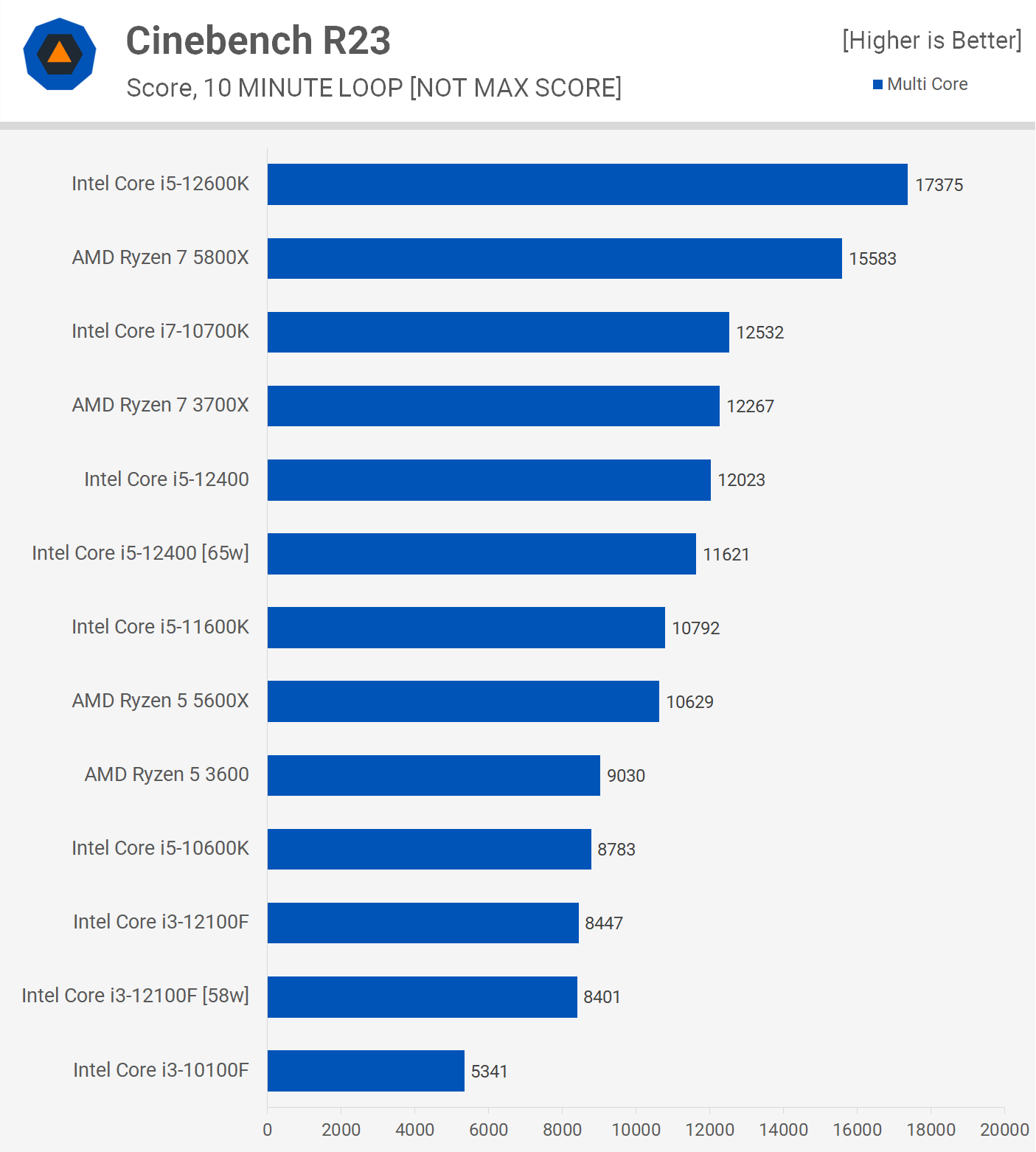
For productivity tasks, the 12100F is going to be fine for light workloads, and by that we mean basic video editing, rendering, and so on. It also means although this is just a quad-core processor, you might have to adjust your expectations for what that looks like in terms of performance, because here we're looking at an almost 60% increase in performance over the previous generation quad-core, the 10100F (there weren't any Rocket Lake quads).
It's also interesting to note that even when limited to the 58w base power spec, the Core i3-1200F delivered basically the same result as the 89w turbo spec, suggesting that this part doesn't use much over 58 watts for its sustained all-core performance. In fact, when monitoring CPU package power we found that the 12100F didn't exceed 57w, at least in this benchmark, so any difference between the two 12100F configurations should be margin of error.
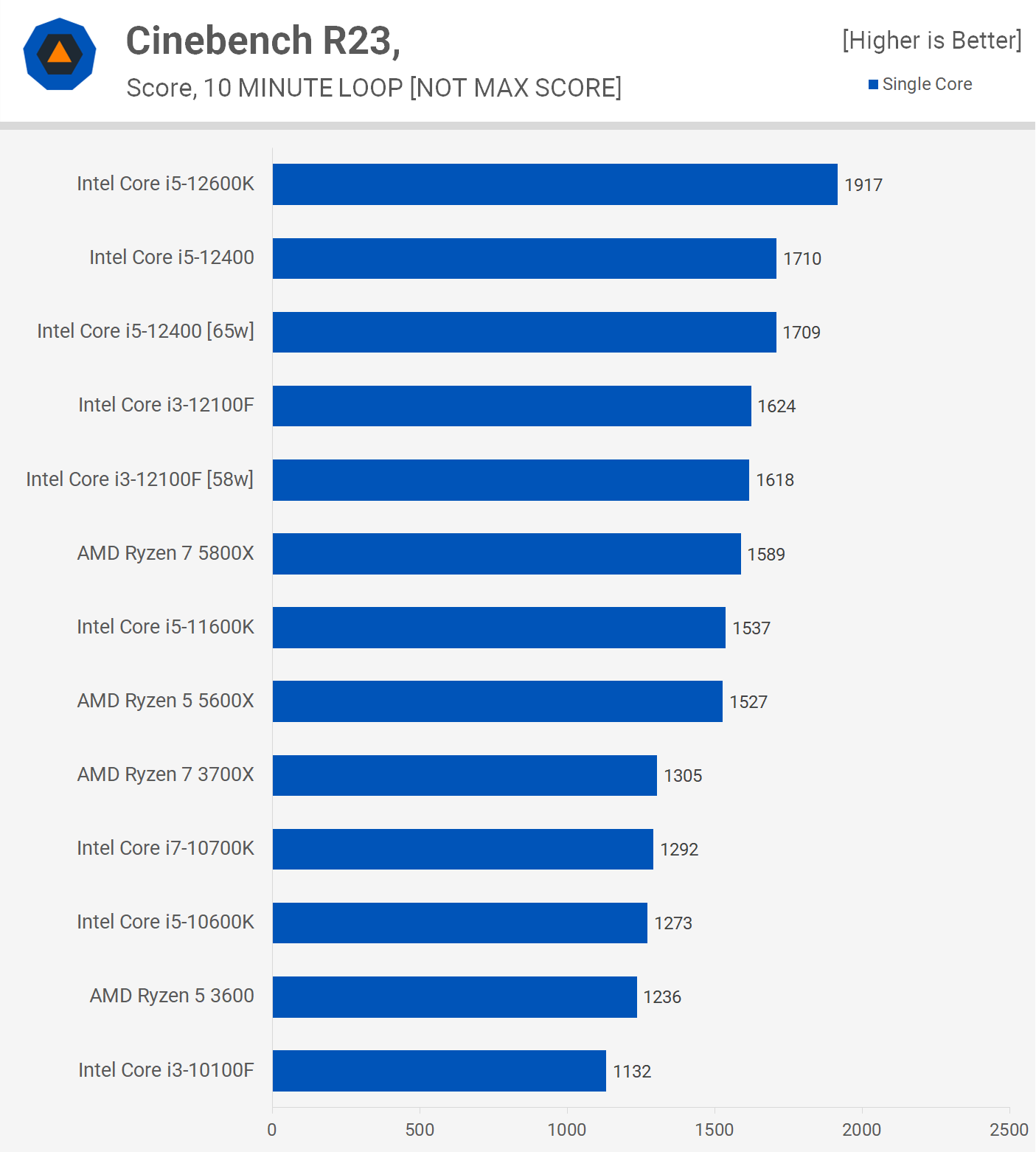
Of course, the reason why the 12100F is so much faster than previous generation quad-cores and is able to match fairly modern 6-core/12-thread processors is because of Alder Lakes strong IPC gains. Here we're looking at comparable single core performance to that of the Ryzen 7 5800X, that's faster than the 11600K and 27% faster than the 10th-gen Core series, very impressive stuff.
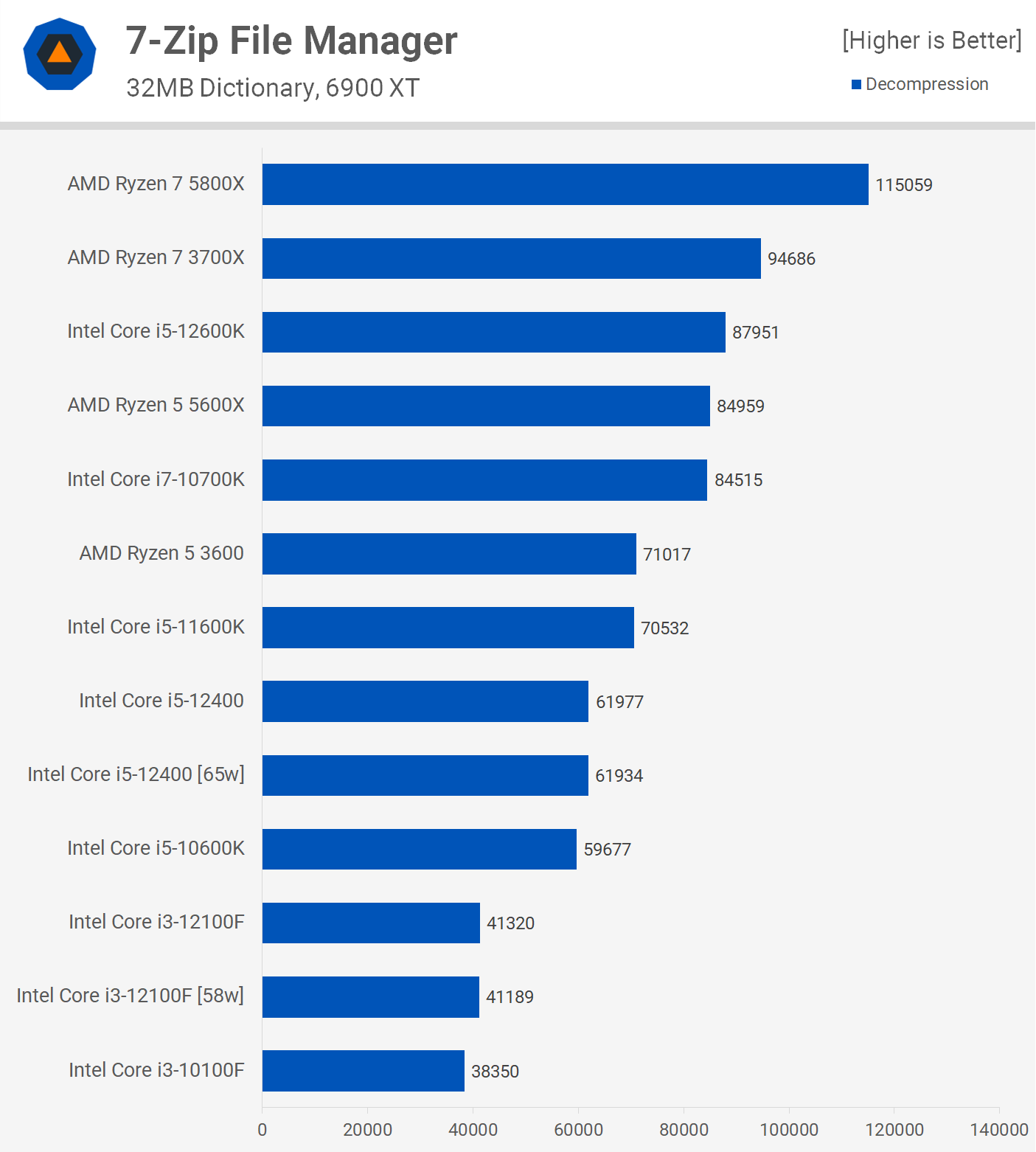
Moving on to 7-Zip File Manager results, the 12100F doesn't look super impressive when it comes to compression performance, but for a CPU that's just over $100, it's kind of great, offering a ~30% boost over the 10100F and just 20 - 22% less performance than 6-core parts in the Core i5-10600K and Ryzen 5 3600.

The decompression performance is a lot less impressive as the 12100F is barely any faster than the 10100F and is now 42% slower than the Ryzen 5 3600.

The 12100F was impressive in the Corona benchmark, completing the test in 174 seconds, though it was 6% slower when power limited. Based on what was seen when observing the package power in Cinebench, this 6% performance difference didn't make sense. So we looked at package power in Corona and it appeared to max out at just 52 watts, which means both configurations should have delivered the same result.
It's possible the package power reporting is inaccurate. Whatever the case, this is the resulting performance when limited to the 58w spec opposed to the 'unlimited' spec, lets say. In short, the 12100F was 39% faster than the 10100F and 17% slower than the Ryzen 5 3600.

For budding content creators, the 12100F isn't a crazy idea. If you're building or upgrading a PC on a tight budget, this is the best level of performance you can get for just over $100, the next best thing would be a 10400F which would be around 10% slower than the 10600K.
But as it stands, the 12100F is just 16% slower than the 10600K and 24% slower than the 12400. But when compared to the 10100F, we're looking at a hefty 42% increase in performance.

The 12100F is also handy for those needing to get some Photoshop work done as the performance is comparable to that of the 11600K, 3700X and 10700K, some pretty high-end CPUs there in comparison. It was also 37% faster than the 10100F, an impressive jump over the previous-gen Core i3 part.
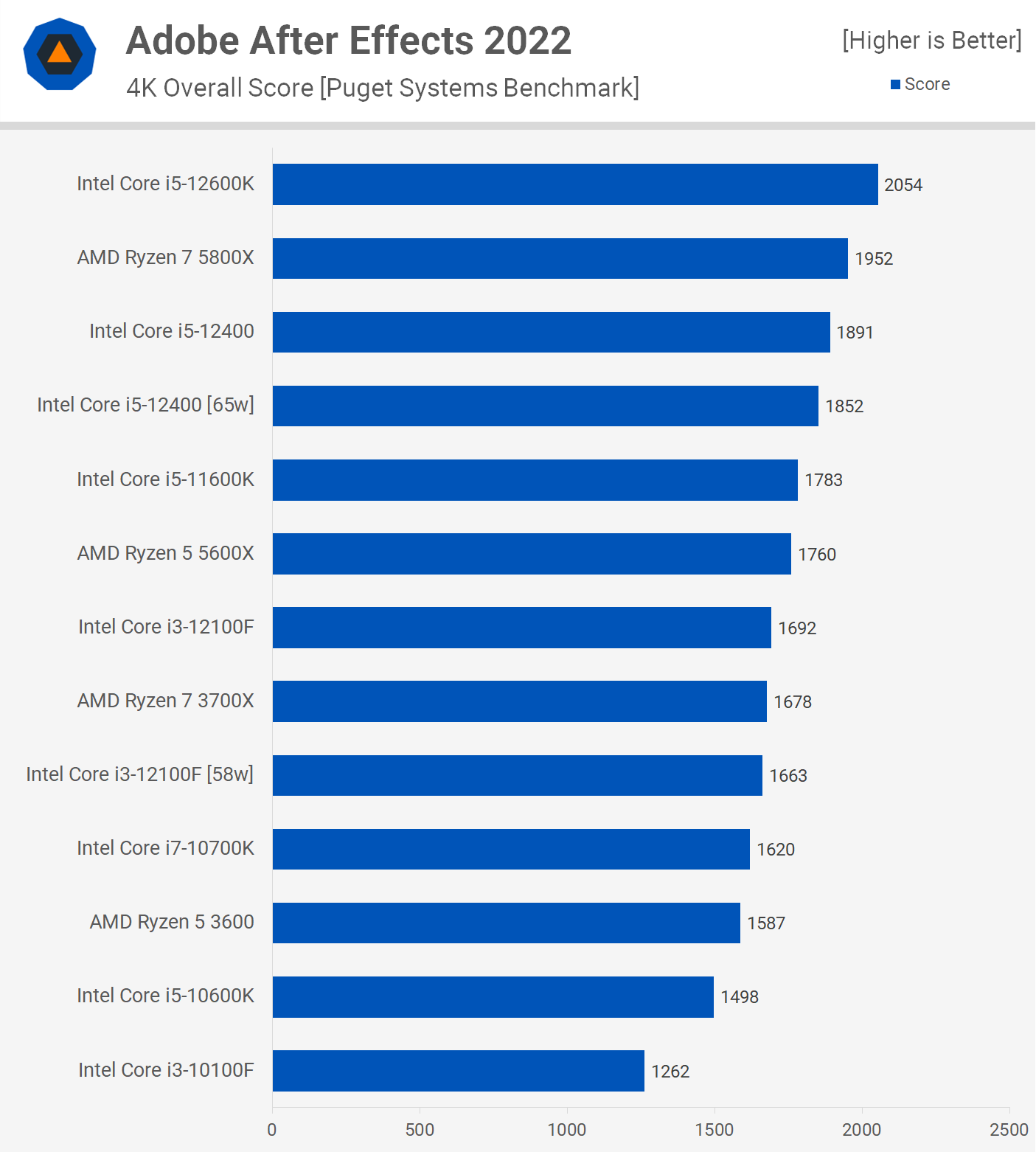
In Adobe After Effects the 12100F appears surprisingly capable, roughly matching the performance of the Ryzen 5 5600X in the Puget Systems Benchmark. I have no doubt that serious users making money from work with After Effects won't opt for the Core i3-12100F, but for those starting out this budget CPU doesn't seem like a bad option, despite being a lowly quad-core.
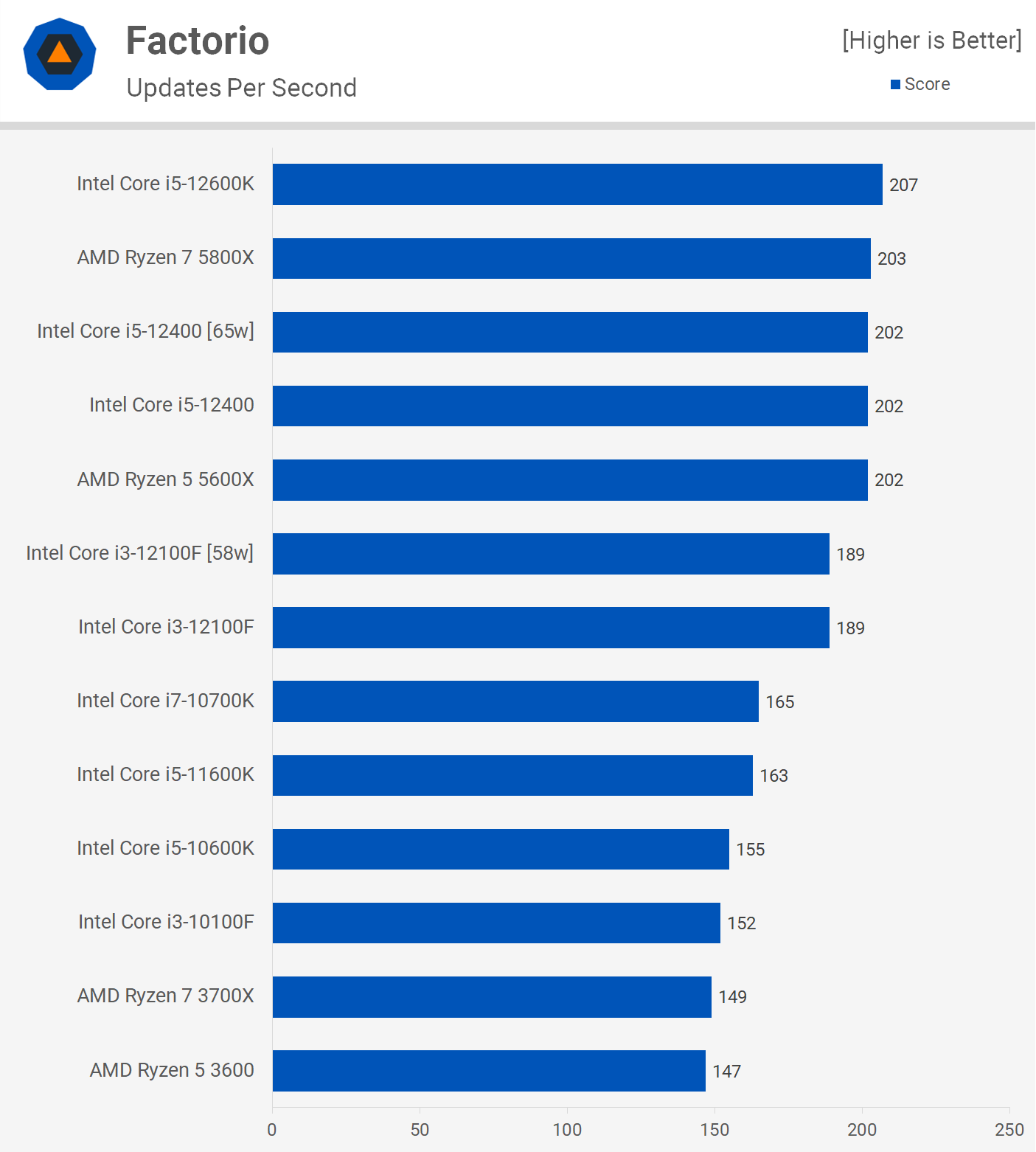
We're including Factorio in the application benchmarks as we're not measuring FPS, but updates per second. This automated benchmark calculates the time it takes to run 1000 updates. This is a single thread test which apparently relies heavily on cache performance.
Due to the strong single core performance of the 12100F, we see that it scores very well with 189 pts making it just 6% slower than the 5600X and 12400, but also 16% faster than the 11600K and 22% faster than the 10600K.

Next up we have code compilation performance and again the 12100F wasn't a great deal slower than previous generation 6-core/12-thread processors such as the 10600K and 3600. We're talking about an 8% increase in completion time. Meanwhile, the 12100F reduced the compile time by over 30% to the 10100F.
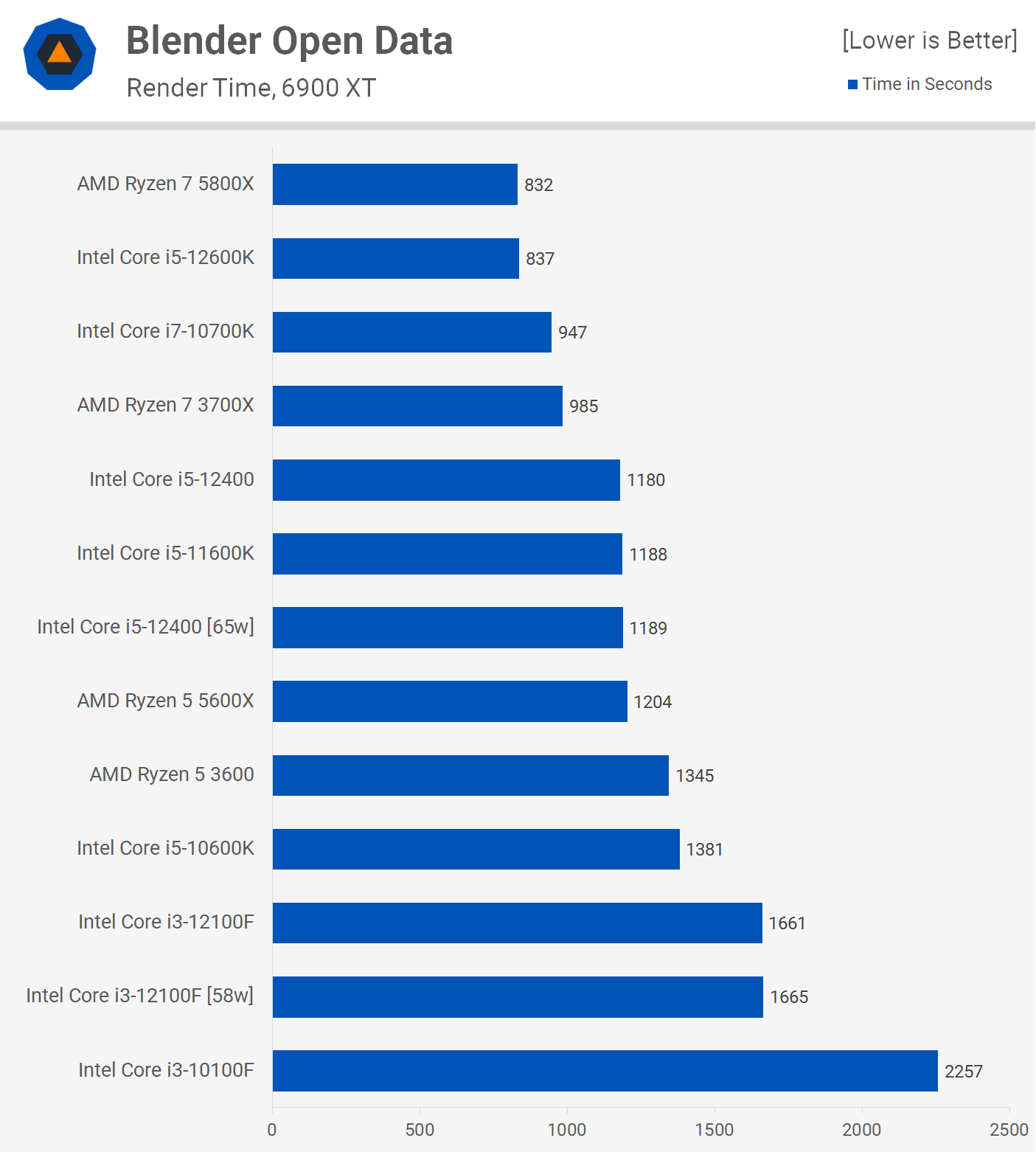
In Blender the margins are fairly similar to what we've already seen. The 12100F reduced the render time by 26% when compared to the 10100F, while it was 21% slower than the 10600K. Essentially you're getting half the performance of the 5800X, while spending 3x less.
Gaming Benchmarks
Time to see how this quad-core handles gaming, and we'll start with a relatively easy title. In F1 2021 the 12100F was capable of driving up to 292 fps on average, while keeping 1% lows above 200 fps. Of course, the 10100F was also very capable in F1 2021, but we're looking at an 18% performance uplift.

Perhaps more important that that, the 12100F was just 6% slower than the 10600K, 10% slower than the 11600K and 12% slower than the 12400F. It's probably worth noting that it was 26% faster than the R5 3600, so overall great performance from this Core i3.

The 12100F was also very capable when testing with Rainbow Six Siege, averaging ~400 fps with 1% lows over 300 fps. This placed it on par with the Ryzen 5 3600 and ahead of both the 11600K and 10600K. When compared to the 10100F, we're seeing a 24% increase in 1% low performance.
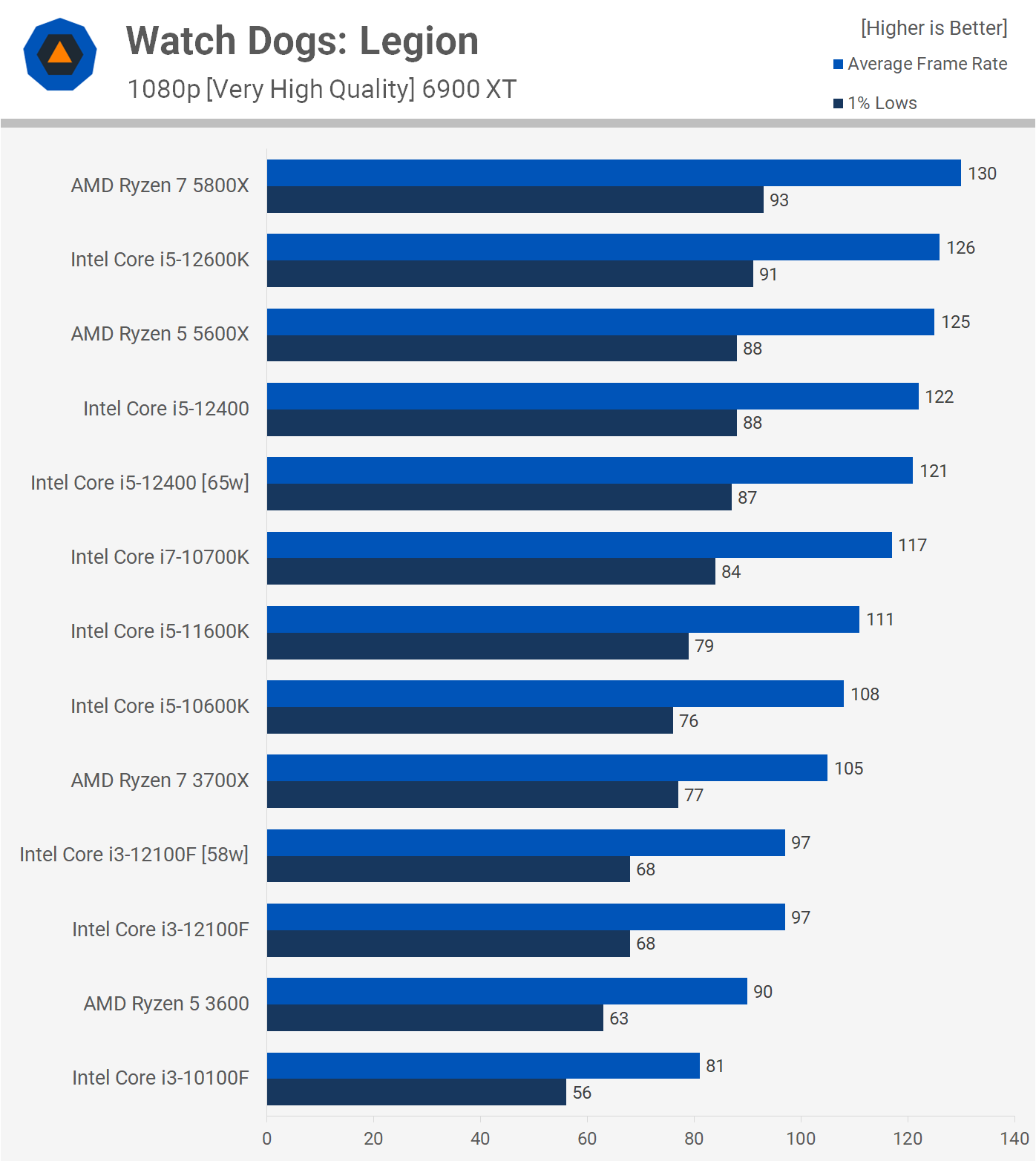
Moving on, we have Watch Dogs: Legion and although 97 fps on average is one of the weaker results from the batch of CPUs tested, the 12100F was 8% faster than the R5 3600 and 20% faster than the 10100F. Moreover, it was ~8% slower than the Ryzen 7 3800X and 10% slower than the Core i5-10600K, both of which are very capable gaming processors.

Next we have Shadow of the Tomb Raider and the village section of the game we use for testing is very CPU demanding. I was shocked to discover that the 12100F's 1% low performance was 51% stronger than that of the 10100F and we're also looking at a 32% increase for the average frame rate. When compared to more expensive parts such as the 5600X, the 12100F was just 18% slower and 20% slower than the 12400.
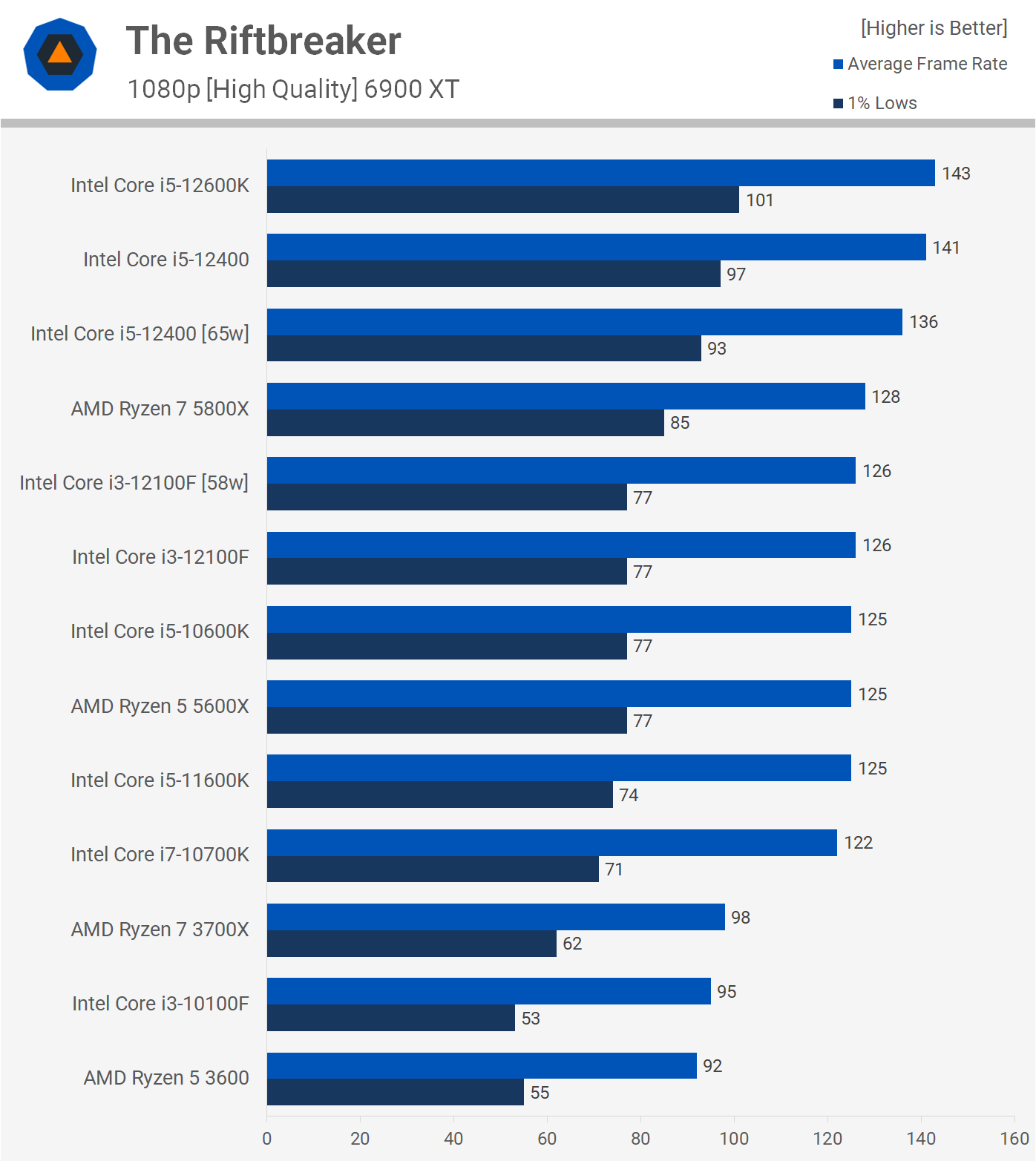
The Riftbreaker is another CPU intensive title, though like most games, single core performance is most important. As a result, the 12100F performs very well allowing for 126 fps on average and that meant it was comparable to the 10600K, 5600X, and 11600K.
When looking at 1% lows, it was 45% faster than the 10100F, and 33% faster when comparing the average FPS.
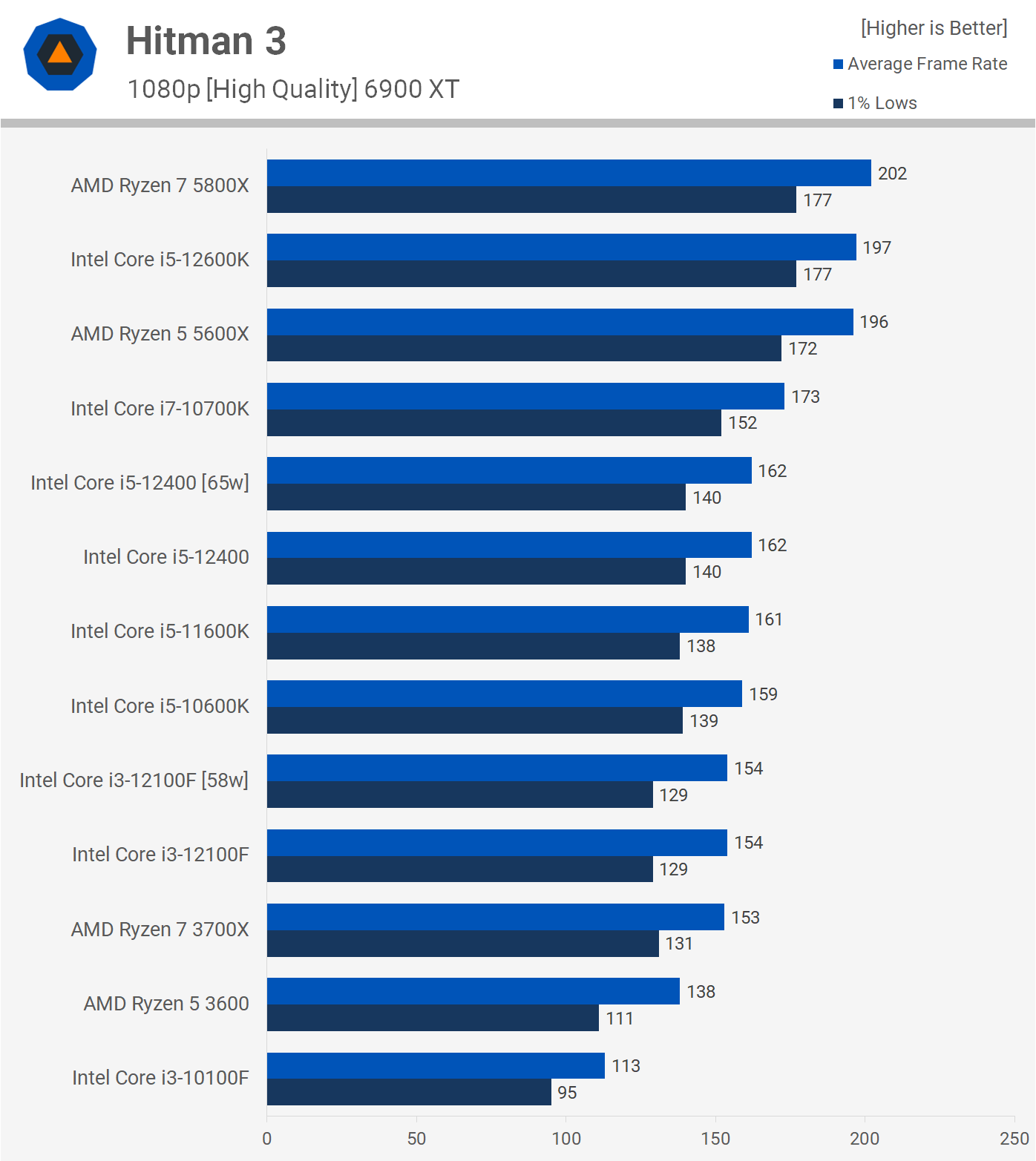
Next we have Hitman 3, and here the 12100F was good for 154 fps on average which is comparable to numerous current and previous generation mid range processors such as the 3700X, 10600K, 11600K, and even the 12400. A strong result and a massive 36% uplift over the old 10100F.
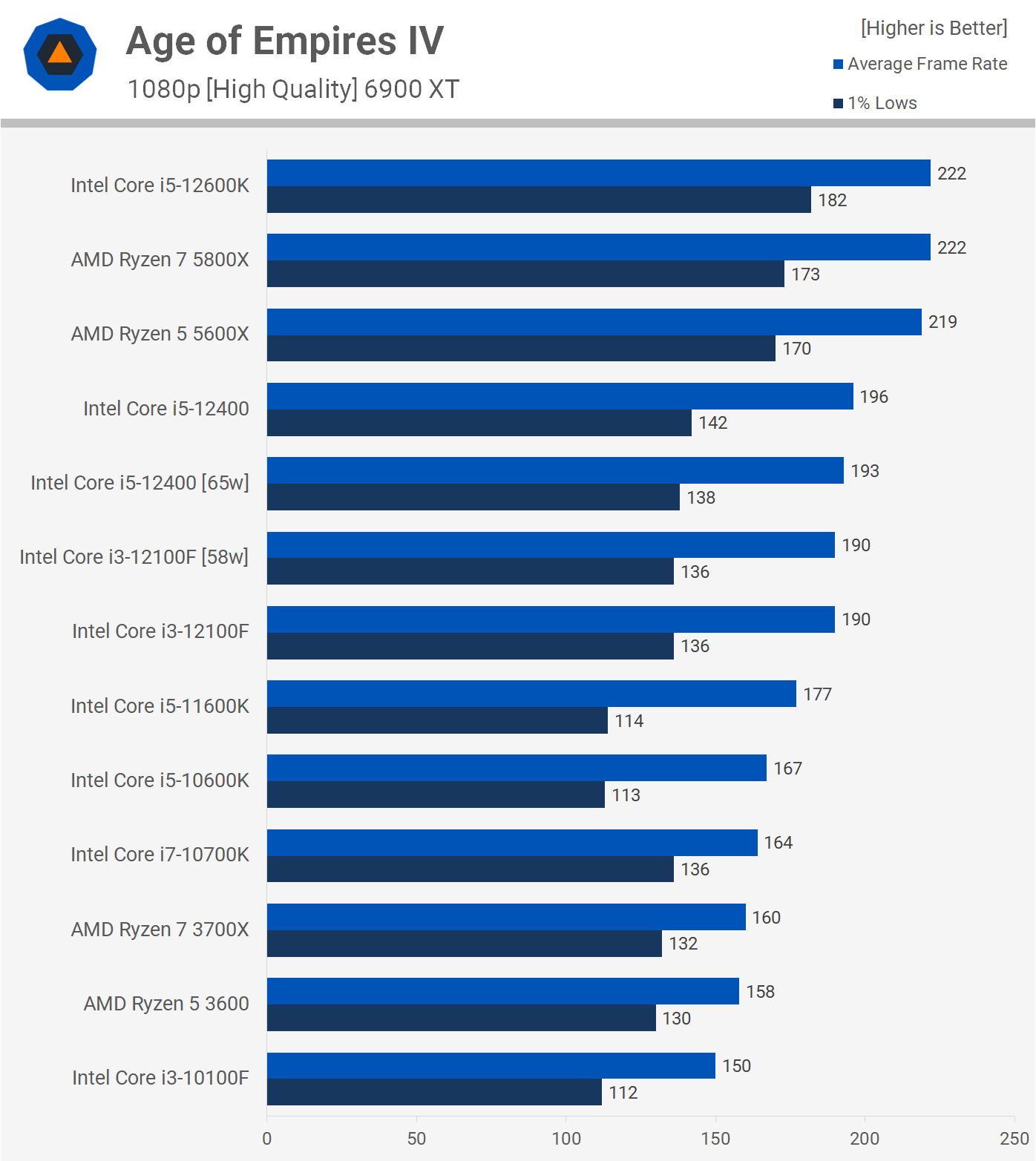
Age of Empires IV relies heavily on single core performance, so the Core i3-12100F does very well allowing for 190 fps on average, which is the same level of performance you'll receive from the i5-12400. It's also a 27% increase from the 10100F and a 20% boost over the Ryzen 5 3600.
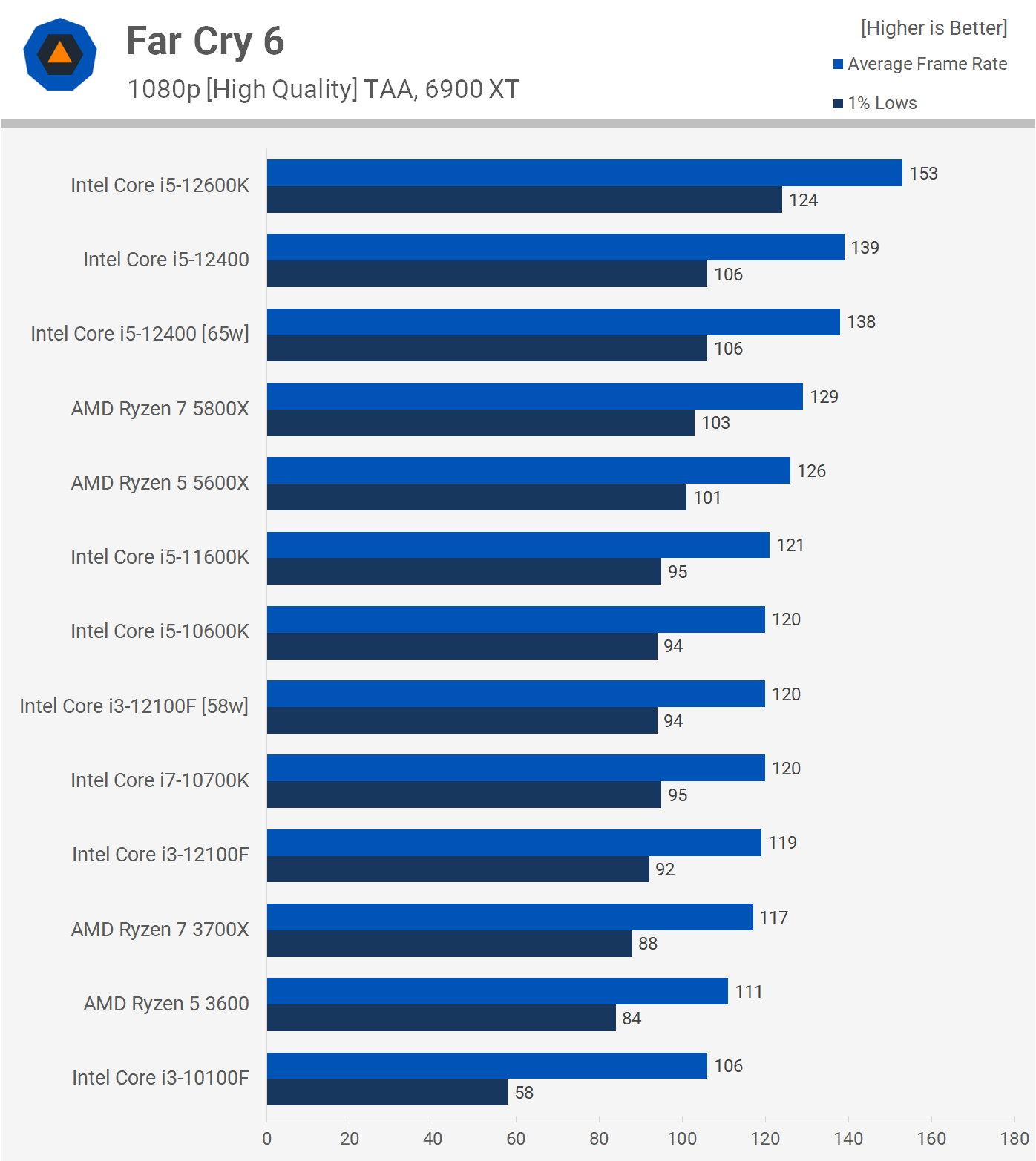
Far Cry 6 is another recent release that only heavily taxes a single thread, and the Core i3-12100F does well delivering similar performance to that of the 11600K, 10600K, 10700K and 3700X. Interestingly though, despite the heavy reliance on the primary thread, the Core i3-10100F does suffer from rather weak 1% low performance in Far Cry 6, whereas this wasn't an issue for the new 12100F.
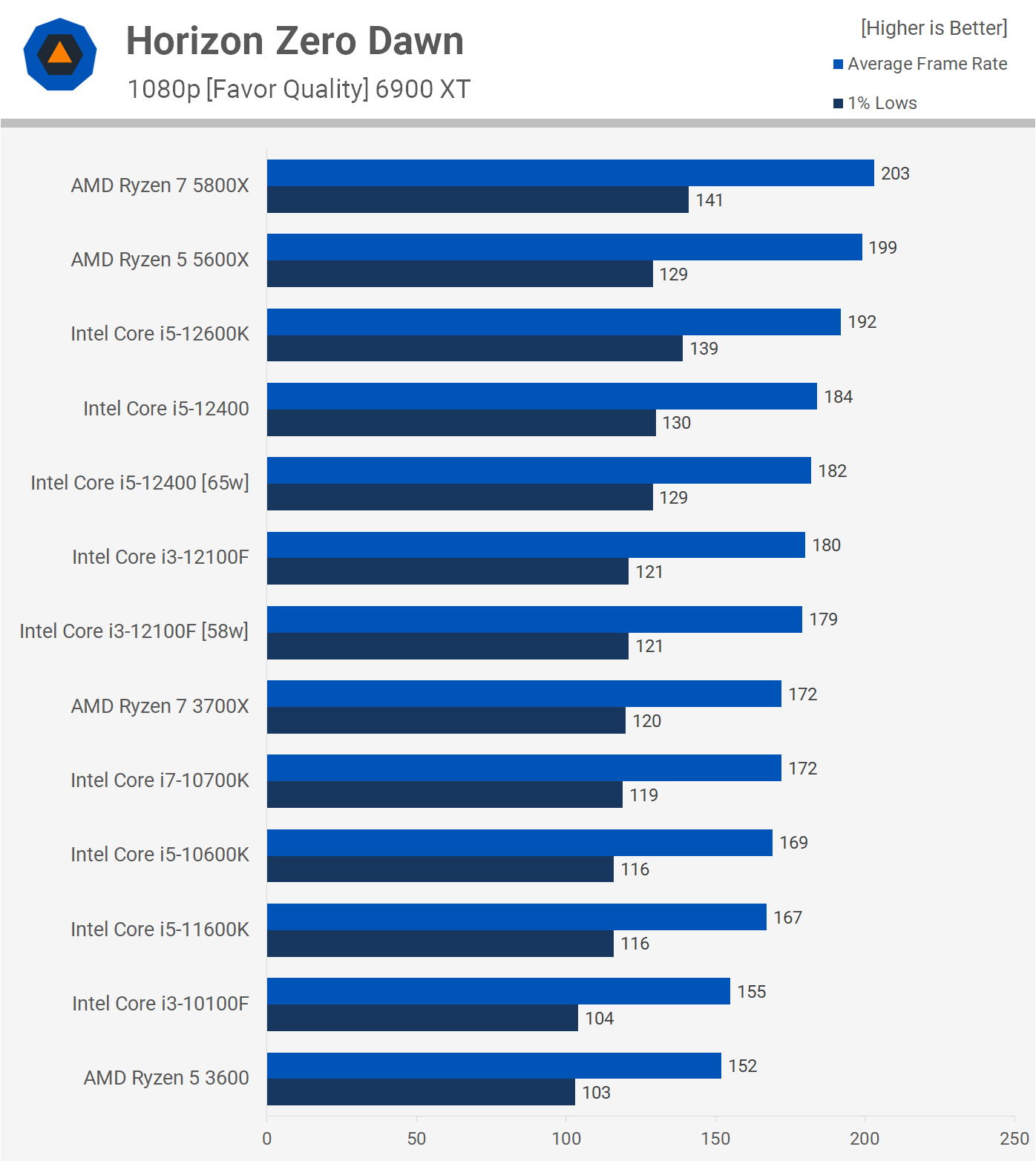
Horizon Zero Dawn isn't a core-heavy game, so we have another example where the 12100F performs well relative to other more expensive CPUs. Basically it's able to match the i5-12400 making it slightly faster than the 3700X and 10700K.

Arguably the most CPU demanding game in our list is Cyberpunk 2077 and the Core i3-12100F was feeling the pressure a little, though overall performance was excellent, basically matching the R5 3600 and R7 3700X.
It was 19% slower than the 10600K and 11600K, and then 24% slower than the i5-12400, so those extra cores, and cache are certainly helping a lot. But 102 fps on average remains decent performance and it was a 16% boost over the previous Core i3.
Power Consumption
When it comes to power consumption, the 12100F is extremely efficient, we're looking at roughly the same total system usage as the 10100F for around 30% greater performance. Incredible performance for a CPU that's only consuming 50-60 watts.

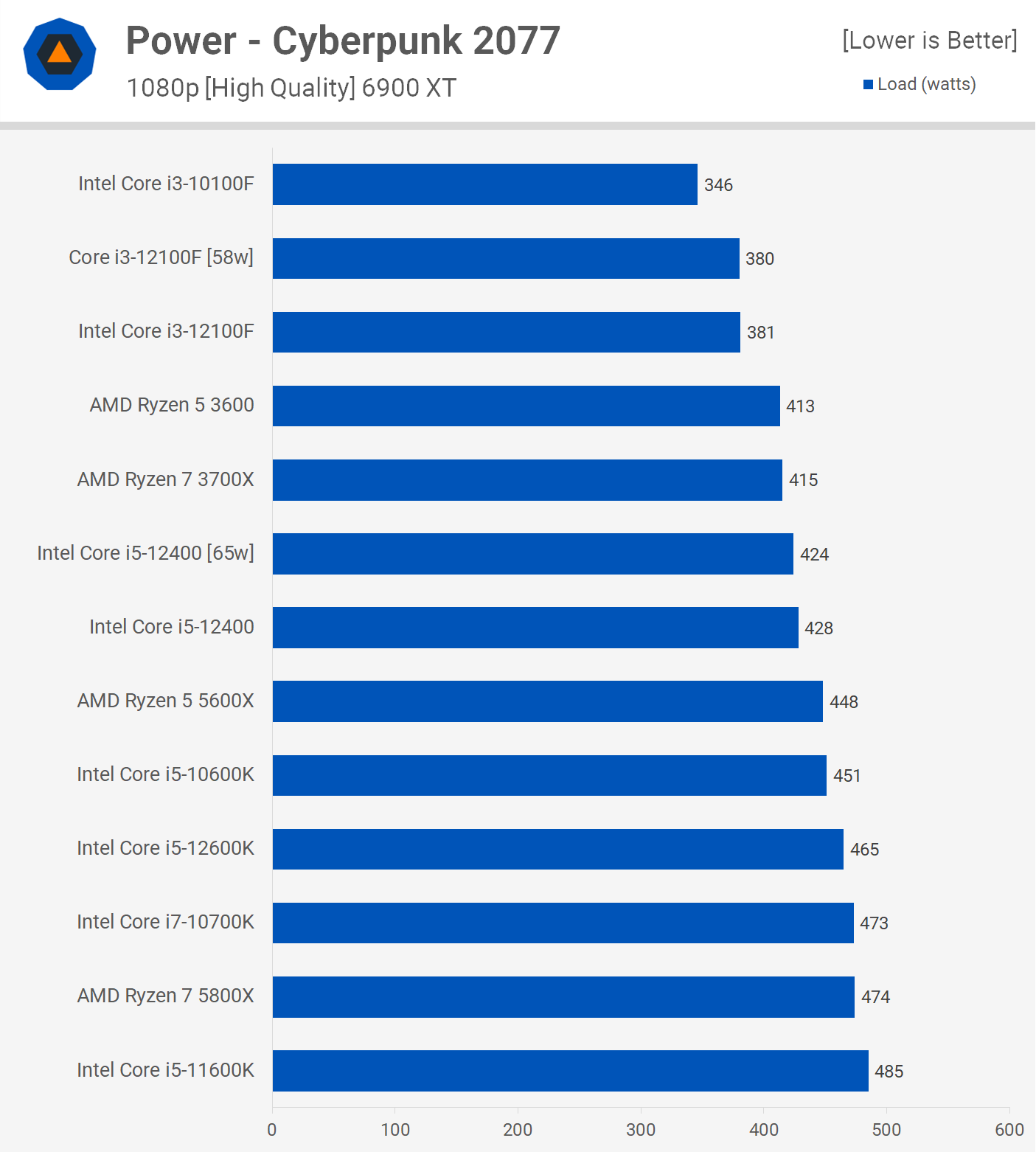
We also tested power consumption with Cyberpunk 2077 and the the 12100F looks impressive, increasing total system usage by just 10% over the 10100F for a 16% boost in performance. Basically, when paired with a mid-range graphics card, a 400 watt power supply would be overkill.
10 Game Average
Here's a look a the 10 game average data and overall we think it's fair to say Intel's latest quad-core made out very well in many of today's games, especially given we were often using slightly dialed down quality settings at 1080p with a Radeon RX 6900 XT.
What this means is, for most gamers who will almost always be more GPU limited, the 12100F is going to fair even better.
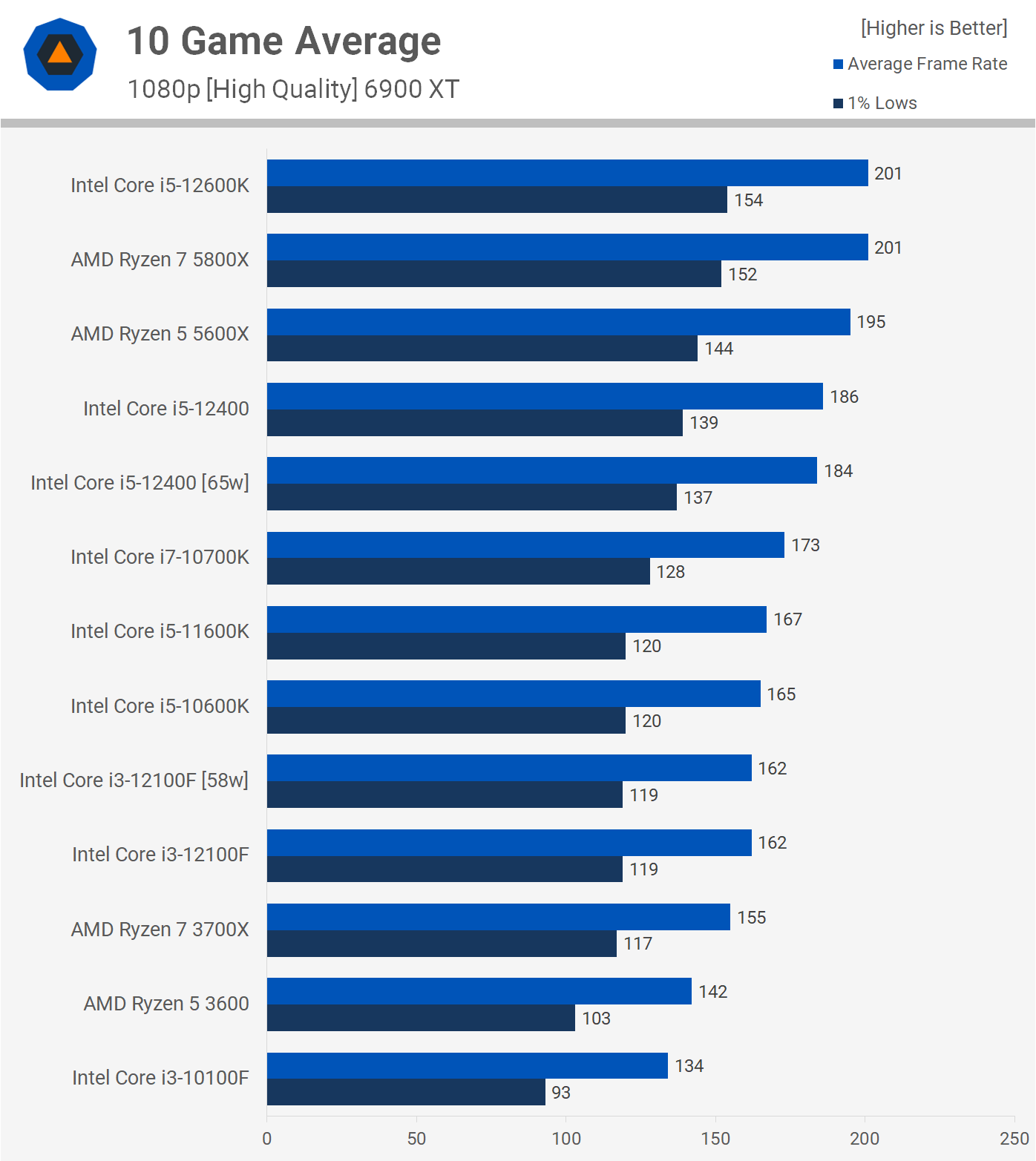
But is also means when more CPU limited in todays games, the 12100F is often comparable to parts such as the Ryzen 7 3700X and Core i5-10600K, which is remarkable.
It's also a huge step up from the Core i3-10100F, boosting 1% lows by 28% on average with a 21% increase for the average frame rate. It's also typically quite a bit punchier than the Ryzen 5 3600, another great budget CPU from years past.
Temps with the Box Cooler
Before wrapping things up, here's a look at operating temperatures with the RS1 box cooler, which is a cut down version of the RM1 which comes with the 12400.
Running at the 58w spec, the 12100F never exceeded 78C and this temperature was reported inside the Corsair Obsidian 500D with an ambient room temperature of 21C. A good result overall.
Unsurprisingly, with the power limits removed we found the same result, 78C peak temperature with a sustained all core clock frequency of 4.1 GHz. So most users should have no issue using the 12100F with the supplied box cooler.
What We Learned
The Core i3-12100F is even more impressive than what we were expecting. Despite only packing four cores, the application performance was excellent, often rivaling that of previous generation 6-core/12-thread processors. Then when it came to gaming it was much more capable than anticipated, often matching higher core count parts while offering substantial performance gains over the previous Core i3 base model.
For those of you building a new budget system, you wouldn't want to consider AMD as the cheapest CPU they have on offer right now would be the Ryzen 3 3100 for $175. That's ~$55 more for vastly inferior performance. Although we didn't test the R3 3100 in this review, we did test the faster R5 3600, which was seen lagging behind the 12100F most of the time, especially for gaming. The next best thing from AMD would be the 5600G, but at $260 it's a hard pass, assuming you're not after the iGPU, but even then it's questionable.
With AMD out of the picture, the 12100F is unrivaled at $120, with the only potential alternative being the cheaper and slower 10100F. The 12th-gen part will set you back an extra $35 for the CPU and about $30 more for the motherboard, but you do get a much faster system with a significantly better upgrade path, should you choose to bolster CPU performance in the future.
All said and done, you can land the Core i3-12100F for around $120, a decent B660 board for $140, and a 16GB DDR4-3200 CL16 kit can be had for just $60, meaning the total platform upgrade is just $320, about what you'd pay for a Ryzen 5 5600X. That configuration is more than capable of tackling all the latest games at sufficiently high frame rates (you will need a GPU of course), and we suspect it will be better than a 'make do' solution for at least the next few years.
Of course, the same package but with the 12400F will set you back $380, just $60 more for a better performing CPU, that should last a bit longer into the future. Personally, we'd go with the Core i5-12400F, but if you really need to cut down costs, then the 12100F on an entry-level B660 board is a very good alternative.
We'll be checking out some H610 motherboards soon and they might make even more sense for those of you considering the 12100F, so stay tuned for that.
